NISSAN NAVARA 2005 Repair Workshop Manual
Manufacturer: NISSAN, Model Year: 2005, Model line: NAVARA, Model: NISSAN NAVARA 2005Pages: 3171, PDF Size: 49.59 MB
Page 791 of 3171
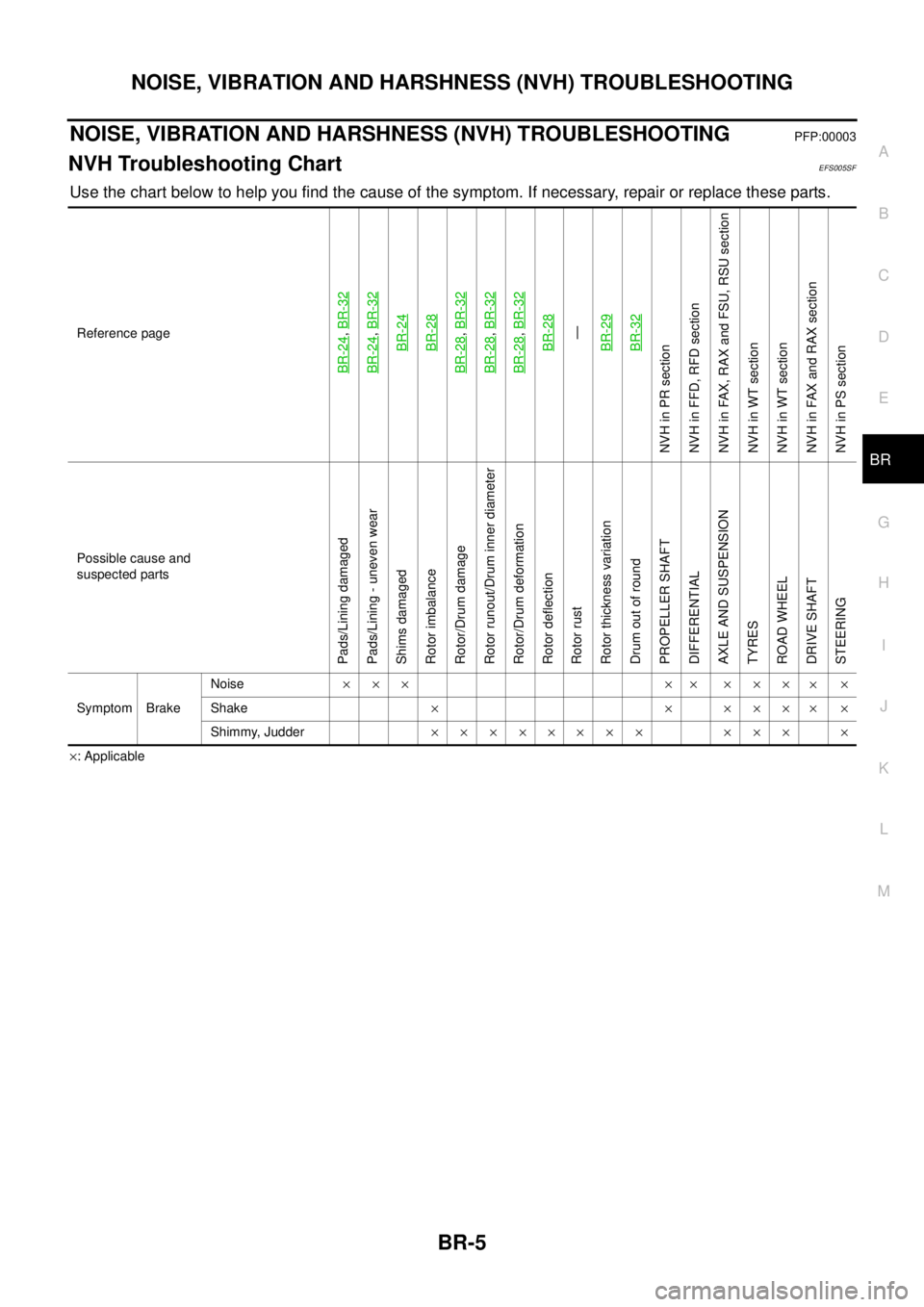
NOISE, VIBRATION AND HARSHNESS (NVH) TROUBLESHOOTING
BR-5
C
D
E
G
H
I
J
K
L
MA
B
BR
NOISE, VIBRATION AND HARSHNESS (NVH) TROUBLESHOOTINGPFP:00003
NVH Troubleshooting ChartEFS005SF
Use the chart below to help you find the cause of the symptom. If necessary, repair or replace these parts.
´: Applicable Reference page
BR-24
,BR-32
BR-24
,BR-32BR-24BR-28
BR-28
,BR-32
BR-28
,BR-32
BR-28
,BR-32BR-28—
BR-29BR-32
NVHinPRsection
NVH in FFD, RFD section
NVH in FAX, RAX and FSU, RSU section
NVH in WT section
NVH in WT section
NVH in FAX and RAX section
NVH in PS section
Possible cause and
suspected parts
Pads/Lining damaged
Pads/Lining - uneven wear
Shims damaged
Rotor imbalance
Rotor/Drum damage
Rotor runout/Drum inner diameter
Rotor/Drum deformation
Rotor deflection
Rotor rust
Rotor thickness variation
Drum out of round
PROPELLER SHAFT
DIFFERENTIAL
AXLE AND SUSPENSION
TYRES
ROAD WHEEL
DRIVE SHAFT
STEERING
Symptom BrakeNoise´´´ ´´ ´´´
´´
Shake´´´´´
´´
Shimmy, Judder´´´´´´´´ ´´´ ´
Page 792 of 3171
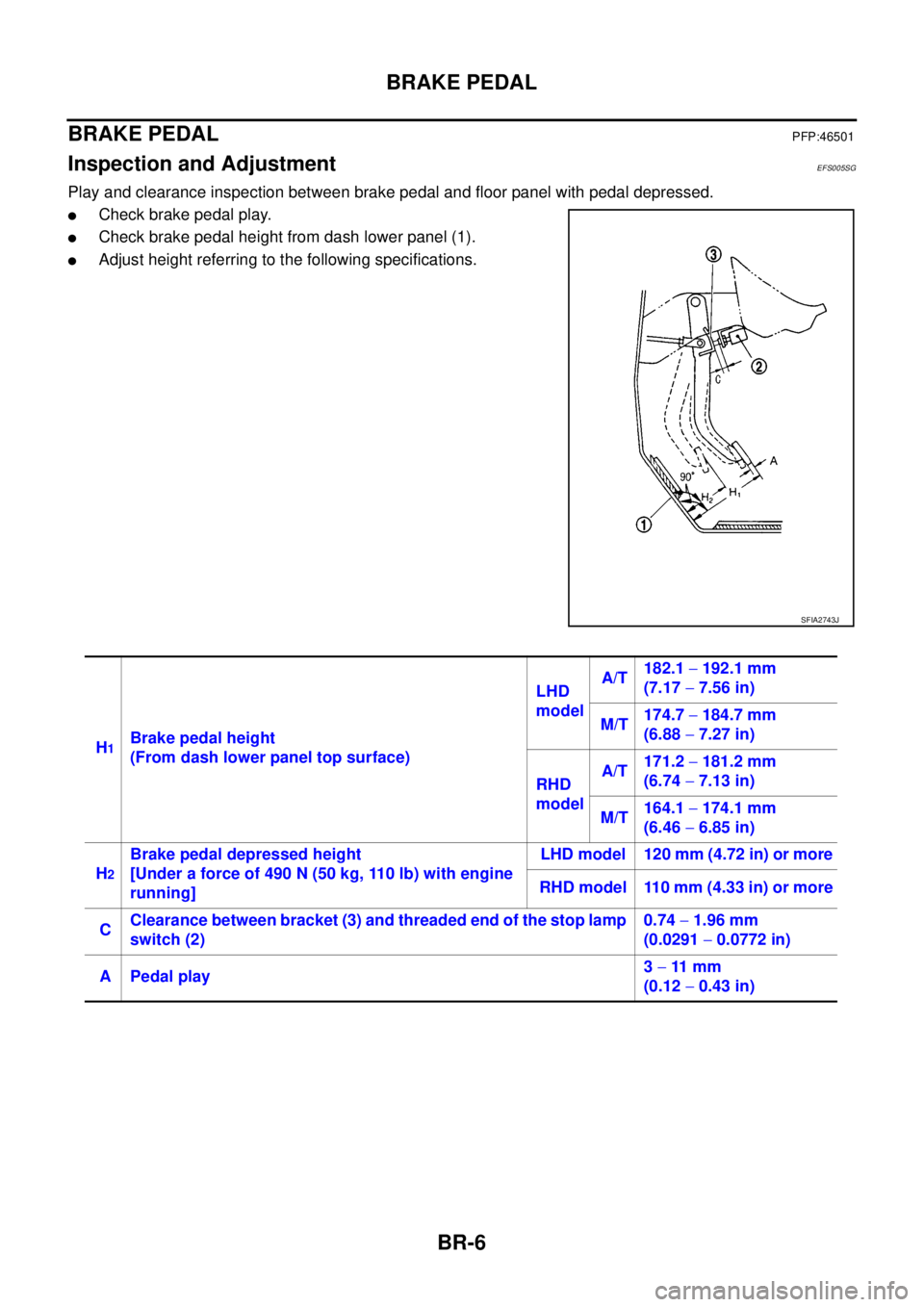
BR-6
BRAKE PEDAL
BRAKE PEDAL
PFP:46501
Inspection and AdjustmentEFS005SG
Play and clearance inspection between brake pedal and floor panel with pedal depressed.
lCheck brake pedal play.
lCheck brake pedal height from dash lower panel (1).
lAdjust height referring to the following specifications.
SFIA2743J
H1Brake pedal height
(From dash lower panel top surface)LHD
modelA/T182.1-192.1 mm
(7.17-7.56 in)
M/T174.7-184.7 mm
(6.88-7.27 in)
RHD
modelA/T171.2-181.2 mm
(6.74-7.13 in)
M/T164.1-174.1 mm
(6.46-6.85 in)
H
2
Brake pedal depressed height
[Under a force of 490 N (50 kg, 110 lb) with engine
running]LHD model 120 mm (4.72 in) or more
RHD model 110 mm (4.33 in) or more
CClearance between bracket (3) and threaded end of the stop lamp
switch (2)0.74-1.96 mm
(0.0291-0.0772 in)
A Pedal play3-11 m m
(0.12-0.43 in)
Page 793 of 3171
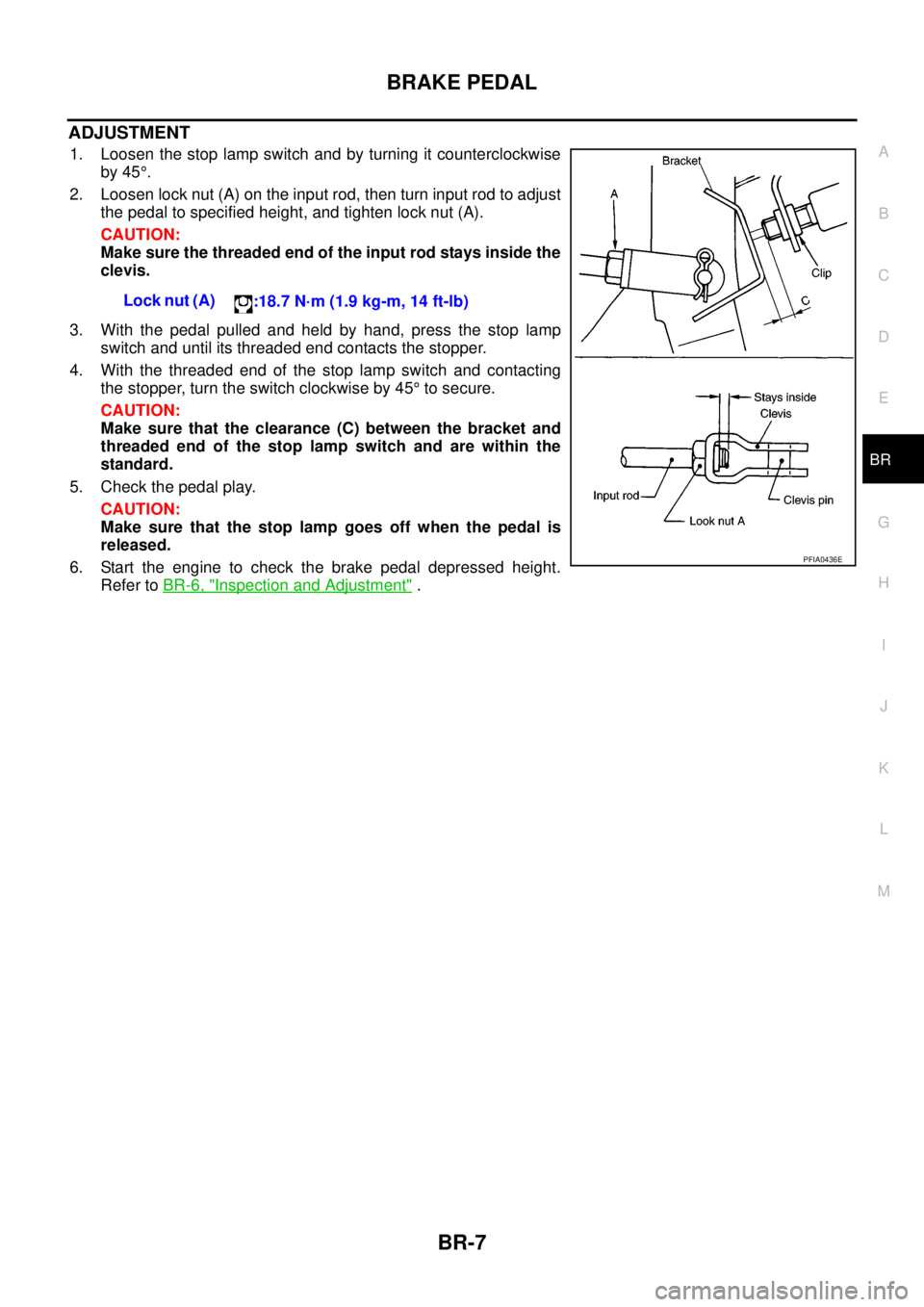
BRAKE PEDAL
BR-7
C
D
E
G
H
I
J
K
L
MA
B
BR
ADJUSTMENT
1. Loosen the stop lamp switch and by turning it counterclockwise
by 45°.
2. Loosen lock nut (A) on the input rod, then turn input rod to adjust
the pedal to specified height, and tighten lock nut (A).
CAUTION:
Make sure the threaded end of the input rod stays inside the
clevis.
3. With the pedal pulled and held by hand, press the stop lamp
switch and until its threaded end contacts the stopper.
4. With the threaded end of the stop lamp switch and contacting
the stopper, turn the switch clockwise by 45°to secure.
CAUTION:
Make sure that the clearance (C) between the bracket and
threaded end of the stop lamp switch and are within the
standard.
5. Check the pedal play.
CAUTION:
Make sure that the stop lamp goes off when the pedal is
released.
6. Start the engine to check the brake pedal depressed height.
Refer toBR-6, "
Inspection and Adjustment". Lock nut (A)
:18.7 N·m (1.9 kg-m, 14 ft-lb)
PFIA0436E
Page 794 of 3171
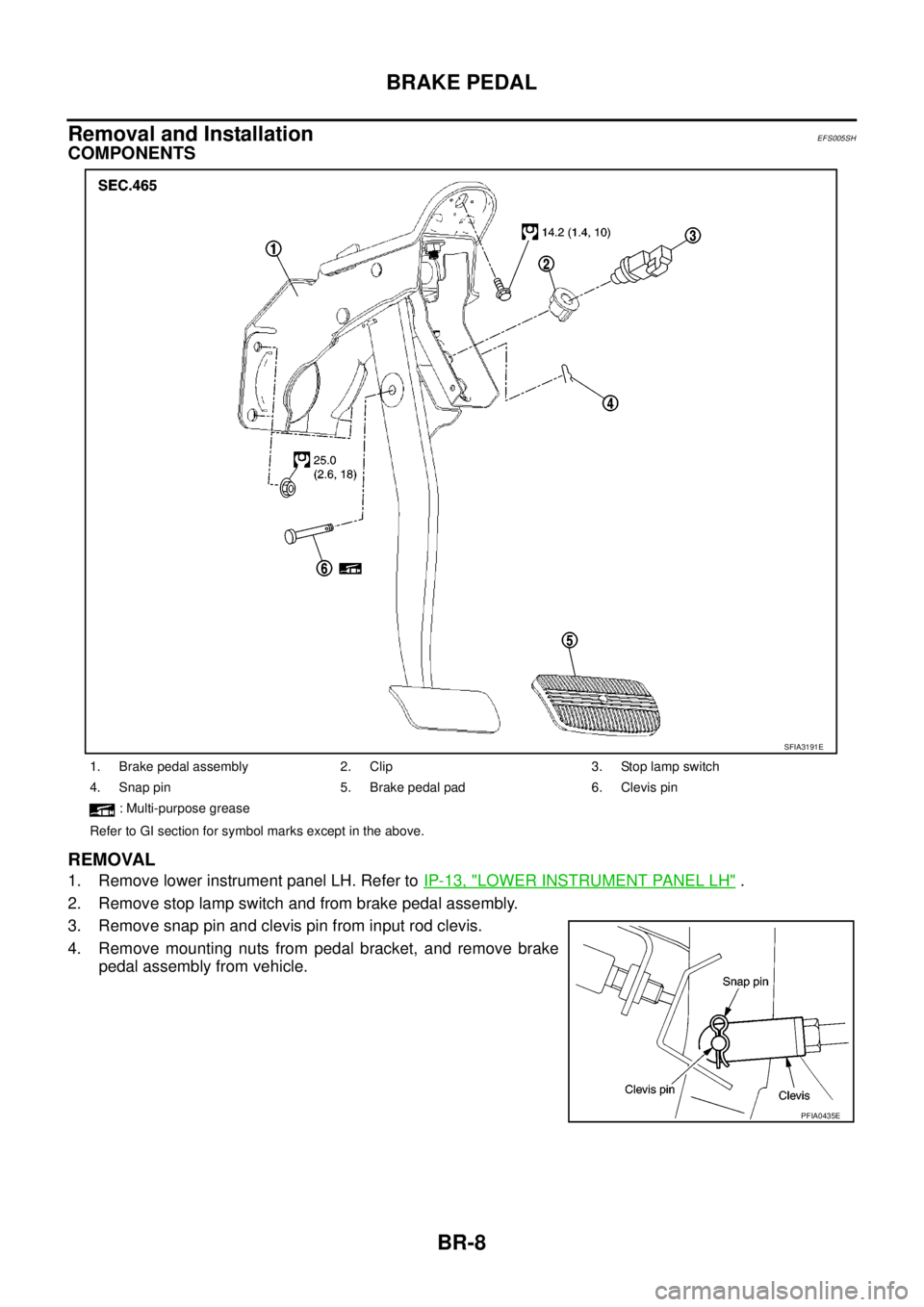
BR-8
BRAKE PEDAL
Removal and Installation
EFS005SH
COMPONENTS
REMOVAL
1. Remove lower instrument panel LH. Refer toIP-13, "LOWER INSTRUMENT PANEL LH".
2. Remove stop lamp switch and from brake pedal assembly.
3. Remove snap pin and clevis pin from input rod clevis.
4. Remove mounting nuts from pedal bracket, and remove brake
pedal assembly from vehicle.
1. Brake pedal assembly 2. Clip 3. Stop lamp switch
4. Snap pin 5. Brake pedal pad 6. Clevis pin
: Multi-purpose grease
Refer to GI section for symbol marks except in the above.
SFIA3191E
PFIA0435E
Page 795 of 3171
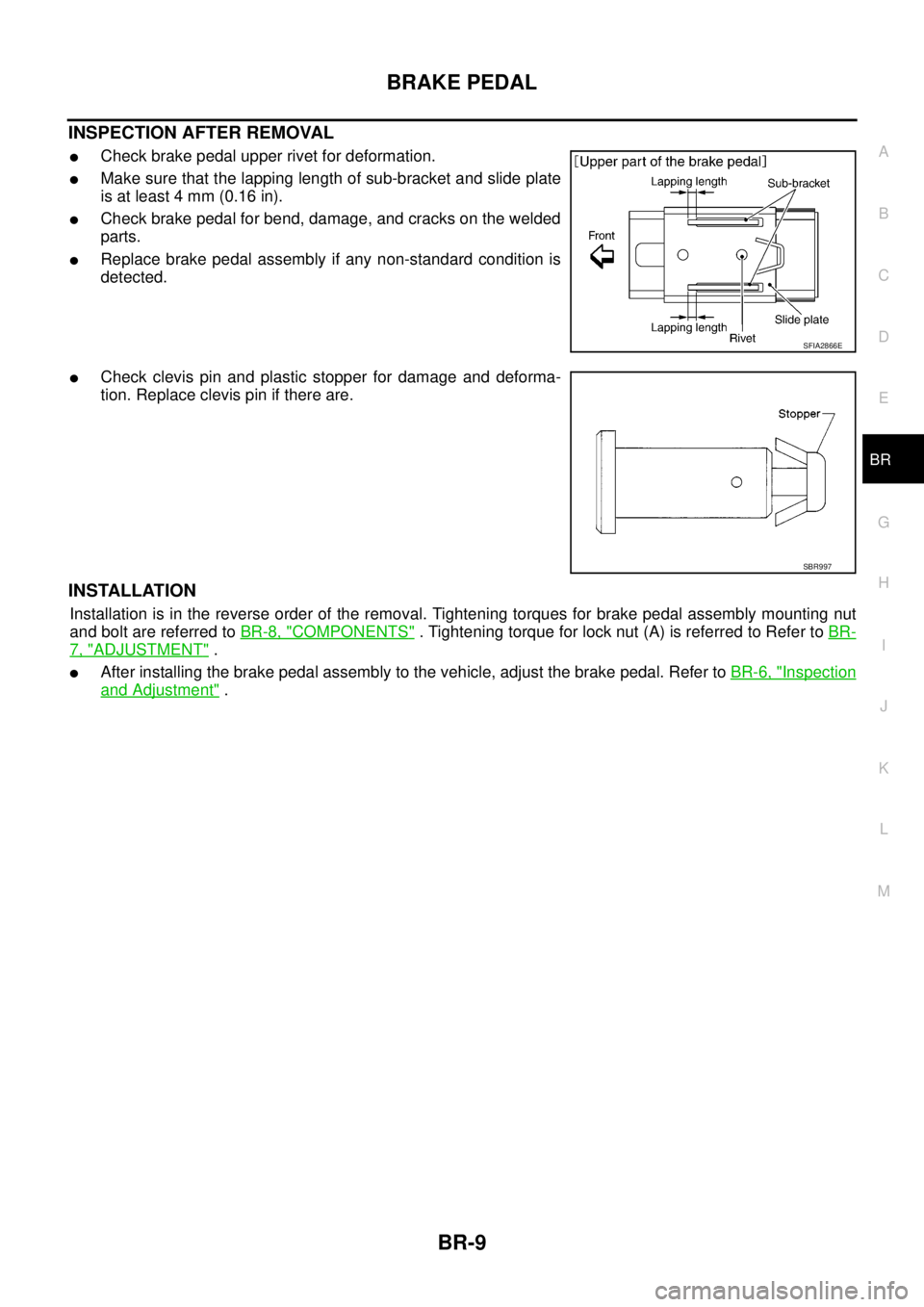
BRAKE PEDAL
BR-9
C
D
E
G
H
I
J
K
L
MA
B
BR
INSPECTION AFTER REMOVAL
lCheck brake pedal upper rivet for deformation.
lMake sure that the lapping length of sub-bracket and slide plate
is at least 4 mm (0.16 in).
lCheck brake pedal for bend, damage, and cracks on the welded
parts.
lReplace brake pedal assembly if any non-standard condition is
detected.
lCheck clevis pin and plastic stopper for damage and deforma-
tion. Replace clevis pin if there are.
INSTALLATION
Installation is in the reverse order of the removal. Tightening torques for brake pedal assembly mounting nut
and bolt are referred toBR-8, "
COMPONENTS". Tightening torque for lock nut (A) is referred to Refer toBR-
7, "ADJUSTMENT".
lAfter installing the brake pedal assembly to the vehicle, adjust the brake pedal. Refer toBR-6, "Inspection
and Adjustment".
SFIA2866E
SBR997
Page 796 of 3171
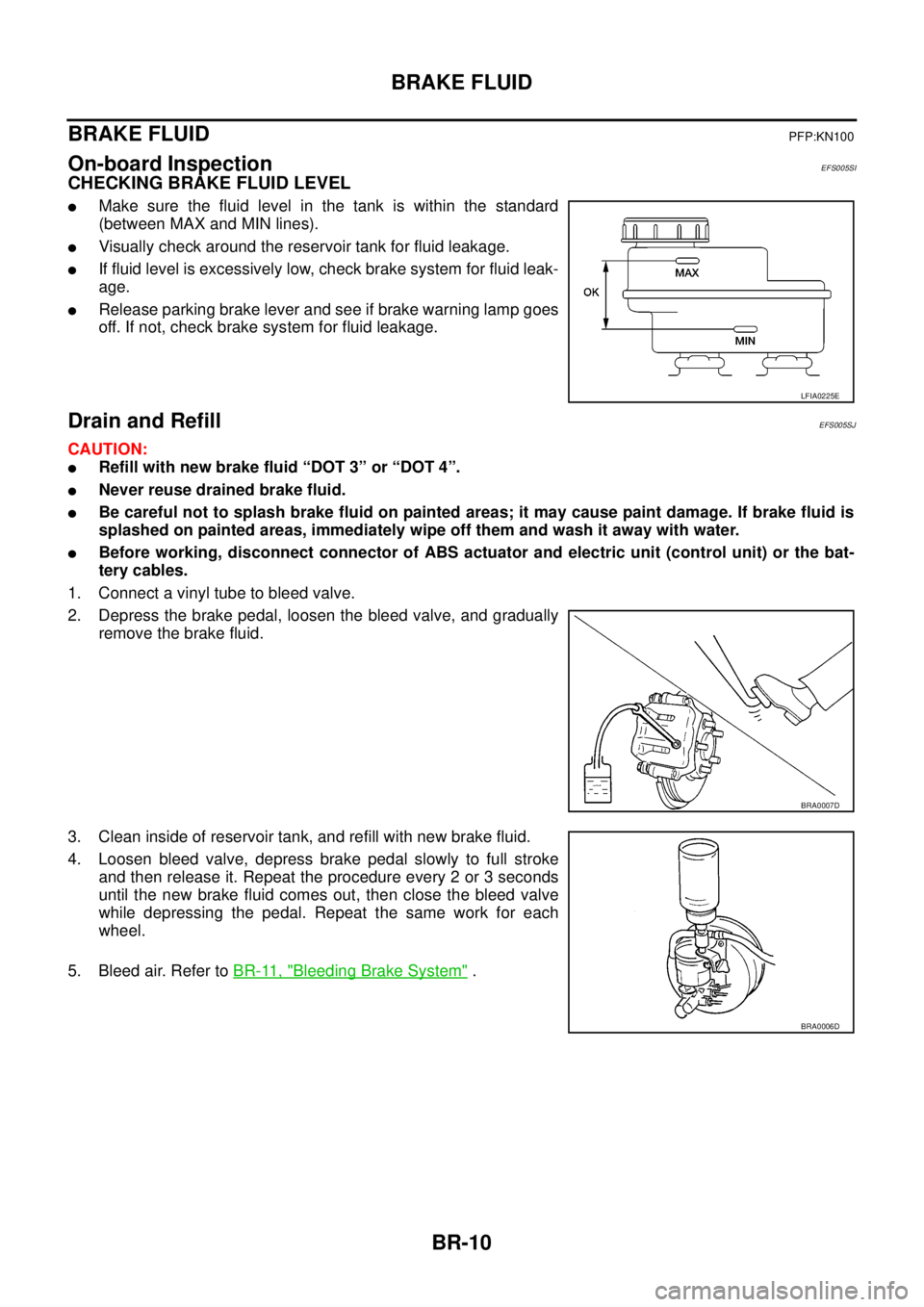
BR-10
BRAKE FLUID
BRAKE FLUID
PFP:KN100
On-board InspectionEFS005SI
CHECKING BRAKE FLUID LEVEL
lMake sure the fluid level in the tank is within the standard
(between MAX and MIN lines).
lVisually check around the reservoir tank for fluid leakage.
lIf fluid level is excessively low, check brake system for fluid leak-
age.
lRelease parking brake lever and see if brake warning lamp goes
off. If not, check brake system for fluid leakage.
Drain and RefillEFS005SJ
CAUTION:
lRefill with new brake fluid “DOT 3” or “DOT 4”.
lNever reuse drained brake fluid.
lBe careful not to splash brake fluid on painted areas; it may cause paint damage. If brake fluid is
splashed on painted areas, immediately wipe off them and wash it away with water.
lBefore working, disconnect connector of ABS actuator and electric unit (control unit) or the bat-
tery cables.
1. Connect a vinyl tube to bleed valve.
2. Depress the brake pedal, loosen the bleed valve, and gradually
remove the brake fluid.
3. Clean inside of reservoir tank, and refill with new brake fluid.
4. Loosen bleed valve, depress brake pedal slowly to full stroke
and then release it. Repeat the procedure every 2 or 3 seconds
until the new brake fluid comes out, then close the bleed valve
while depressing the pedal. Repeat the same work for each
wheel.
5. Bleed air. Refer toBR-11, "
Bleeding Brake System".
LFIA0225E
BRA0007D
BRA0006D
Page 797 of 3171
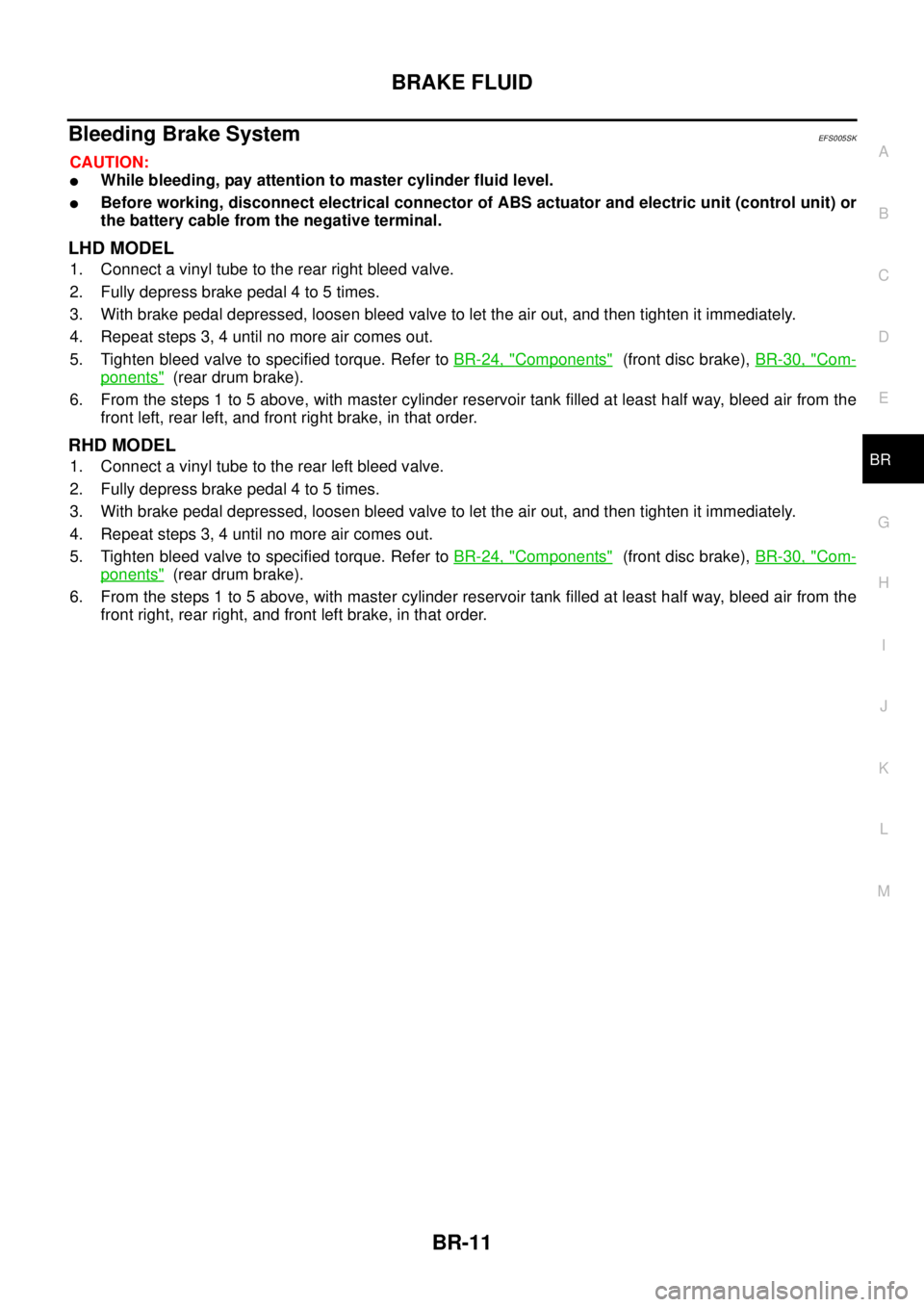
BRAKE FLUID
BR-11
C
D
E
G
H
I
J
K
L
MA
B
BR
Bleeding Brake SystemEFS005SK
CAUTION:
lWhile bleeding, pay attention to master cylinder fluid level.
lBefore working, disconnect electrical connector of ABS actuator and electric unit (control unit) or
the battery cable from the negative terminal.
LHD MODEL
1. Connect a vinyl tube to the rear right bleed valve.
2. Fully depress brake pedal 4 to 5 times.
3. With brake pedal depressed, loosen bleed valve to let the air out, and then tighten it immediately.
4. Repeat steps 3, 4 until no more air comes out.
5. Tighten bleed valve to specified torque. Refer toBR-24, "
Components"(front disc brake),BR-30, "Com-
ponents"(rear drum brake).
6. From the steps 1 to 5 above, with master cylinder reservoir tank filled at least half way, bleed air from the
front left, rear left, and front right brake, in that order.
RHD MODEL
1. Connect a vinyl tube to the rear left bleed valve.
2. Fully depress brake pedal 4 to 5 times.
3. With brake pedal depressed, loosen bleed valve to let the air out, and then tighten it immediately.
4. Repeat steps 3, 4 until no more air comes out.
5. Tighten bleed valve to specified torque. Refer toBR-24, "
Components"(front disc brake),BR-30, "Com-
ponents"(rear drum brake).
6. From the steps 1 to 5 above, with master cylinder reservoir tank filled at least half way, bleed air from the
front right, rear right, and front left brake, in that order.
Page 798 of 3171
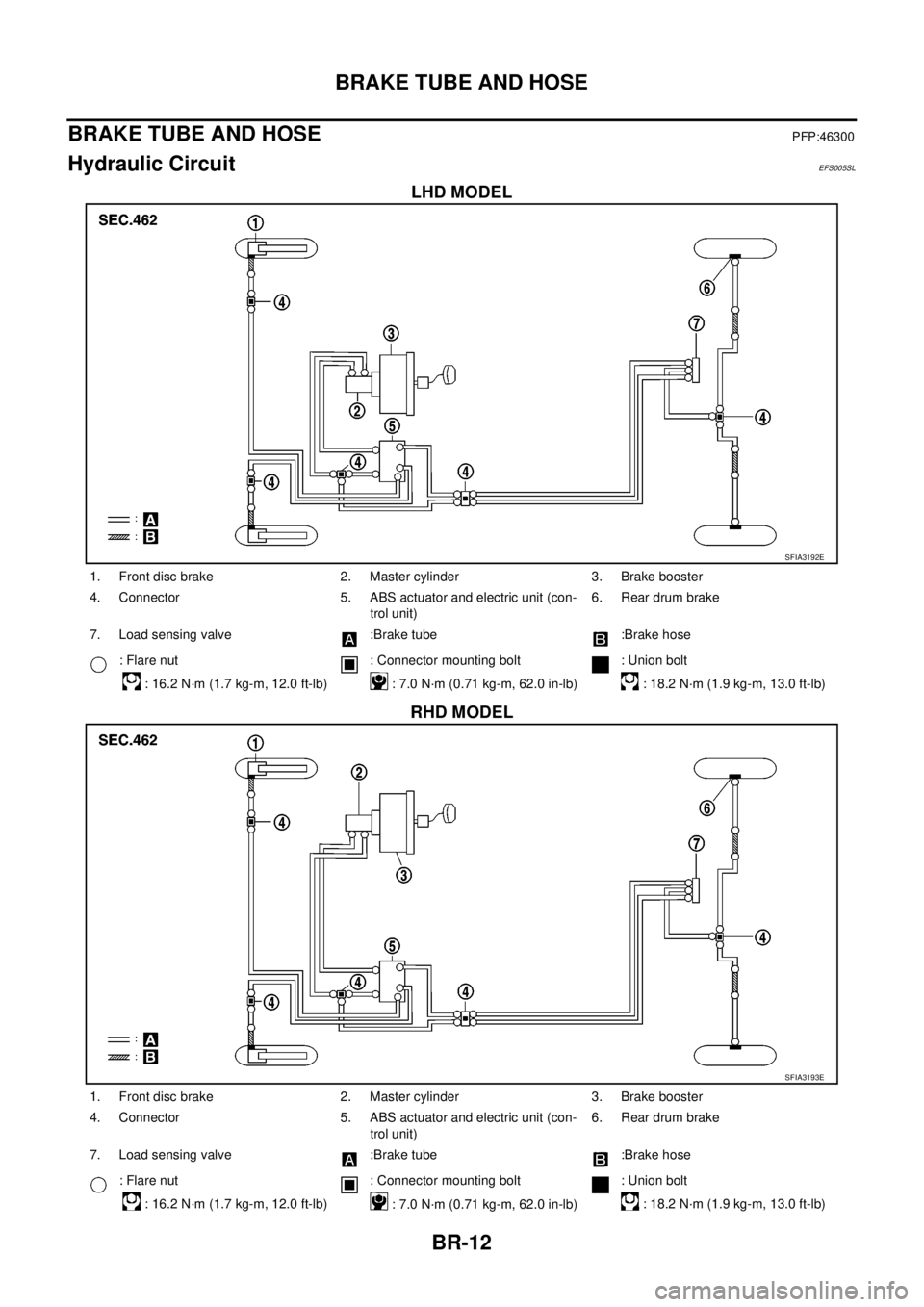
BR-12
BRAKE TUBE AND HOSE
BRAKE TUBE AND HOSE
PFP:46300
Hydraulic CircuitEFS005SL
LHD MODEL
RHD MODEL
SFIA3192E
1. Front disc brake 2. Master cylinder 3. Brake booster
4. Connector 5. ABS actuator and electric unit (con-
trol unit)6. Rear drum brake
7. Load sensing valve :Brake tube :Brake hose
: Flare nut
: 16.2 N·m (1.7 kg-m, 12.0 ft-lb): Connector mounting bolt
: 7.0 N·m (0.71 kg-m, 62.0 in-lb): Union bolt
: 18.2 N·m (1.9 kg-m, 13.0 ft-lb)
SFIA3193E
1. Front disc brake 2. Master cylinder 3. Brake booster
4. Connector 5. ABS actuator and electric unit (con-
trol unit)6. Rear drum brake
7. Load sensing valve :Brake tube :Brake hose
: Flare nut
: 16.2 N·m (1.7 kg-m, 12.0 ft-lb): Connector mounting bolt
: 7.0 N·m (0.71 kg-m, 62.0 in-lb): Union bolt
: 18.2 N·m (1.9 kg-m, 13.0 ft-lb)
Page 799 of 3171
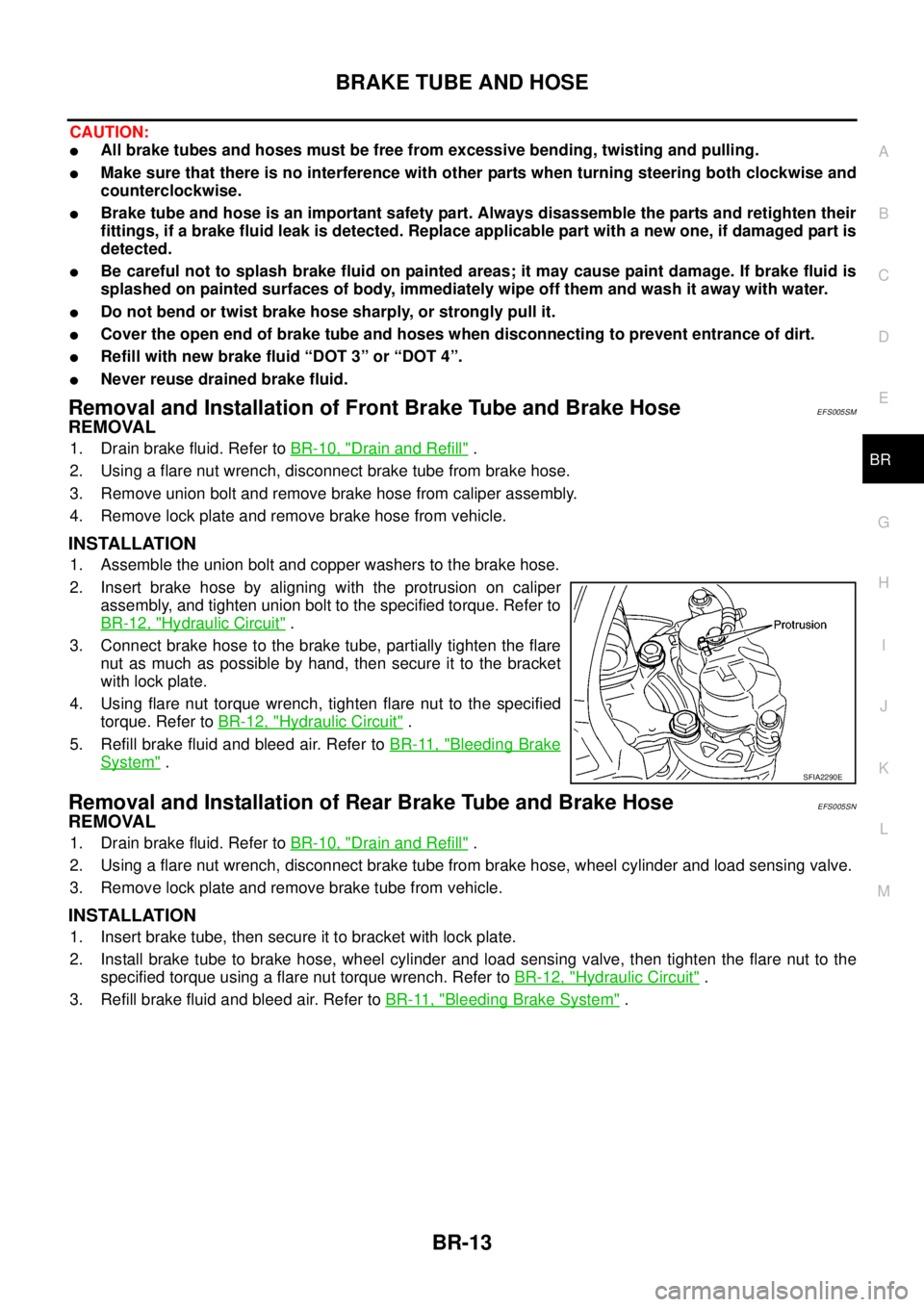
BRAKE TUBE AND HOSE
BR-13
C
D
E
G
H
I
J
K
L
MA
B
BR
CAUTION:
lAll brake tubes and hoses must be free from excessive bending, twisting and pulling.
lMake sure that there is no interference with other parts when turning steering both clockwise and
counterclockwise.
lBrake tube and hose is an important safety part. Always disassemble the parts and retighten their
fittings, if a brake fluid leak is detected. Replace applicable part with a new one, if damaged part is
detected.
lBe careful not to splash brake fluid on painted areas; it may cause paint damage. If brake fluid is
splashed on painted surfaces of body, immediately wipe off them and wash it away with water.
lDo not bend or twist brake hose sharply, or strongly pull it.
lCover the open end of brake tube and hoses when disconnecting to prevent entrance of dirt.
lRefill with new brake fluid “DOT 3” or “DOT 4”.
lNever reuse drained brake fluid.
Removal and Installation of Front Brake Tube and Brake HoseEFS005SM
REMOVAL
1. Drain brake fluid. Refer toBR-10, "Drain and Refill".
2. Using a flare nut wrench, disconnect brake tube from brake hose.
3. Remove union bolt and remove brake hose from caliper assembly.
4. Remove lock plate and remove brake hose from vehicle.
INSTALLATION
1. Assemble the union bolt and copper washers to the brake hose.
2. Insert brake hose by aligning with the protrusion on caliper
assembly, and tighten union bolt to the specified torque. Refer to
BR-12, "
Hydraulic Circuit".
3. Connect brake hose to the brake tube, partially tighten the flare
nut as much as possible by hand, then secure it to the bracket
with lock plate.
4. Using flare nut torque wrench, tighten flare nut to the specified
torque. Refer toBR-12, "
Hydraulic Circuit".
5. Refill brake fluid and bleed air. Refer toBR-11, "
Bleeding Brake
System".
Removal and Installation of Rear Brake Tube and Brake HoseEFS005SN
REMOVAL
1. Drain brake fluid. Refer toBR-10, "Drain and Refill".
2. Using a flare nut wrench, disconnect brake tube from brake hose, wheel cylinder and load sensing valve.
3. Remove lock plate and remove brake tube from vehicle.
INSTALLATION
1. Insert brake tube, then secure it to bracket with lock plate.
2. Install brake tube to brake hose, wheel cylinder and load sensing valve, then tighten the flare nut to the
specified torque using a flare nut torque wrench. Refer toBR-12, "
Hydraulic Circuit".
3. Refill brake fluid and bleed air. Refer toBR-11, "
Bleeding Brake System".
SFIA2290E
Page 800 of 3171

BR-14
BRAKE TUBE AND HOSE
Inspection after Installation
EFS005SO
CAUTION:
Brake tubes and hoses are important safety parts. Always disassemble the parts and retighten their fit-
tings, if a brake fluid leak is detected. Replace applicable part with a new one, if damaged part is
detected.
1. Check hydraulic brake lines (tubes and hoses) and connections for fluid leakage, damage, twists, defor-
mations, contacts with other parts, and loose connections. Replace any damage parts.
2. While depressing brake pedal under a force of 785 N (80 kg, 177 lb) with engine running at idle speed for
approximately 5 seconds, check each part for fluid leakage.